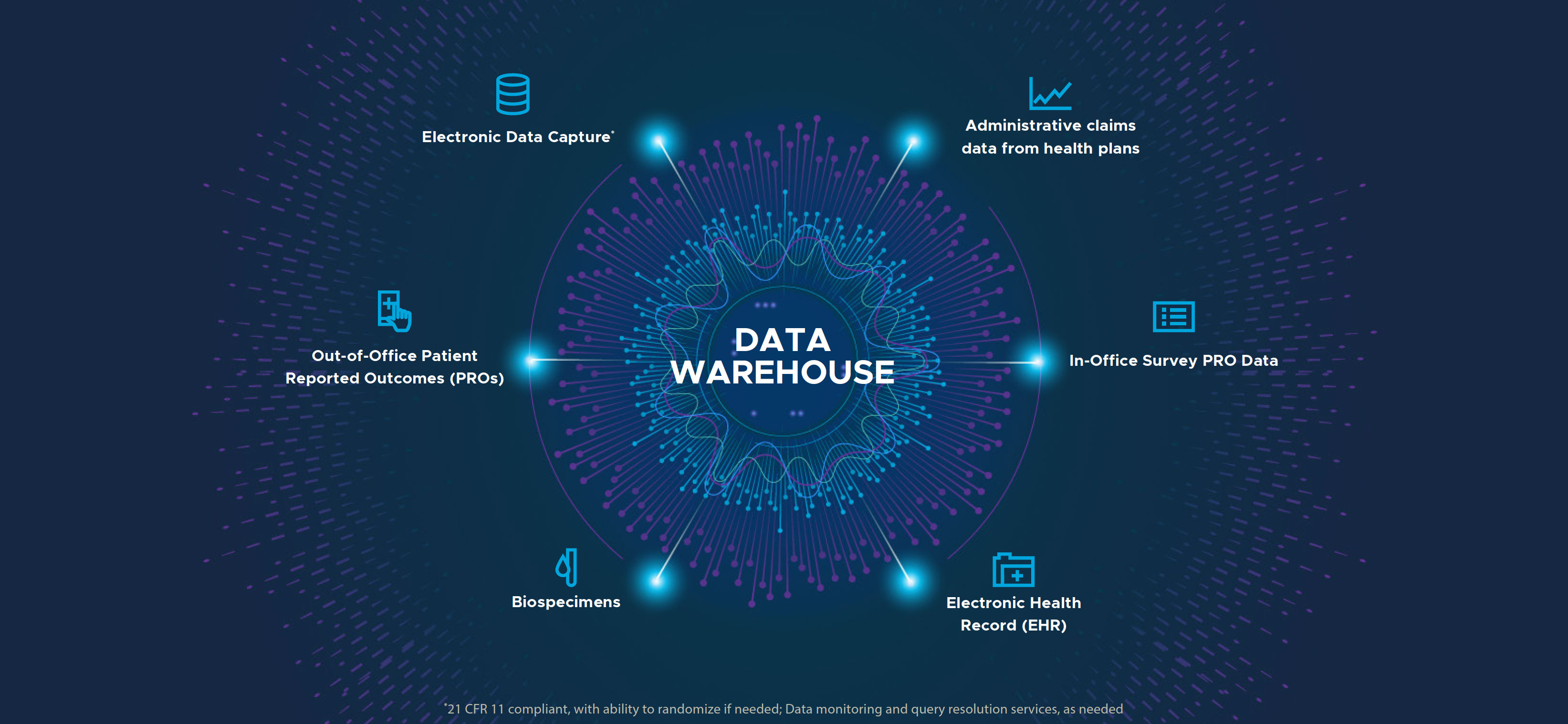The Data
Data Collection
Real-world evidence is only attainable with high-quality, real-world data. Our rigorous extract-transform-load (ETL) process normalizes data from our electronic health record (EHR) platform and maps it to our industry-standard common data model. After being brought into our data warehouse, it undergoes multiple cleaning and normalization processes to shape it into a well curated data warehouse. Both structured and unstructured data elements are included.
Our complete and expansive encounter data is augmented by real-time, intelligently delivered questions and instruments, and allows us to both extract and deliver tailored content at the point of care and beyond. Data linkages with external data sources such as health plan and claims data is available, depending on the need. Our goal is to provide a 360 degree view of patients as they journey with their chronic illness. Conjoined with patient reported outcome (PRO) data collected both in-office and out-of-office, we nimbly augment the data with just about anything that patients can tell us, embedded into routine practice. Our easily customizable electronic data capture (EDC) system gathers everything else, at the point of care. We are the only repository that also has exclusive access to the patient and physician via reported outcomes tools and customized questionnaires.
Data Warehouse
We have the world’s largest real-world, real-time prospective rheumatology data repository, which lives securely on Amazon Web Services (AWS) servers. Our comprehensive data and analytics platform simultaneously aggregate information from a myriad of sources. Our platform also includes a database of more than 1 million active patients and is integrated by additional software, tools, and intelligent analytics that are linked to meaningful data elements within the Illumination Health Platform to deliver actionable insights and new scientific knowledge.

Patients
Providers
Unique Data Points
Unique Indications
Making Data Useful
Once data is collected, it is made unified and usable as if from a single source. The tagging engine digitizes all attributes of the patient such as demographics, meds, indications. Providers are tagged based on their patients, prescription history, and treated diseases. We can also tokenize with our PII and link to any 3rd party data source (e.g. external EDC system, PCORnet, a biomarker dataset. The PCORnet Common Data Model (CDM) is a key component of the PCORnet Distributed Research Network (DRN) infrastructure. PCORnet developed the PCORnet DRN to be a “functional distributed research network that facilitates multi-site patient-centered research across the Clinical Research Networks (CRNs) and other interested contributors. The distributed network will enable the conduct of observational research and clinical trials while allowing each participating organization to maintain physical and operational control over its data.”1

Making Data Visual
The Visualizer allows providers to observe and engage with their data and activity in real time. For research and quality improvement purposes, this system captures data from all platforms and displays the results via digital on-line dashboards based on the clients’ requirements. It includes activity tracking, as well as cohort detail through the engagement and deidentifies the data, as appropriate.
Analyzing The Data
What makes our analytics team unique is our access to the network of physicians creating the data. Most data networks consist of a look-don’t-touch approach to data. Because our data comes directly from the clinical record, in its native state, we have one of the most complete inflammatory data sets available. Additionally, if your research project requires unique data elements, they can be deployed and successfully captured immediately. PROS can be deployed into the patient experience such that the very next patient to complete their onboarding process receives the new requirement to complete.
Transforming Outcomes with
Accelerated AI
The platform captures all financial and clinical elements (structured and unstructured), diagnoses, problem lists, current and past medications, lab results, biometric data, health care claims, past and future scheduled visit information, and patient-generated data, including patient reported outcomes (PROs) comprised of 14 Clinical Algorithms. They are living, breathing workflows that provide decision support and creating rheumatology-specific intelligence. We automate these patient care workflows and provide meaningful education and insights to advance the patient journey and outcomes. The platform was built to be system agnostic, allowing it to intake data from any source providing us the entire patient record, rather than just claims or QPP data. By leveraging this data as a whole, we can course correct patients to the path of best outcome.
IMPROVE
patient journeys
INFLUENCE
the payor
EMPOWER
physicians



